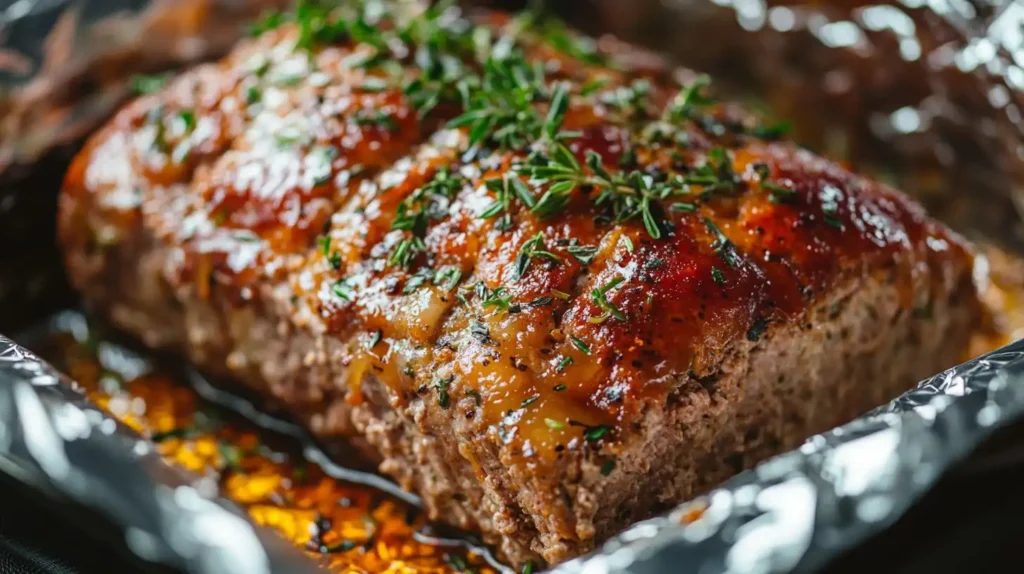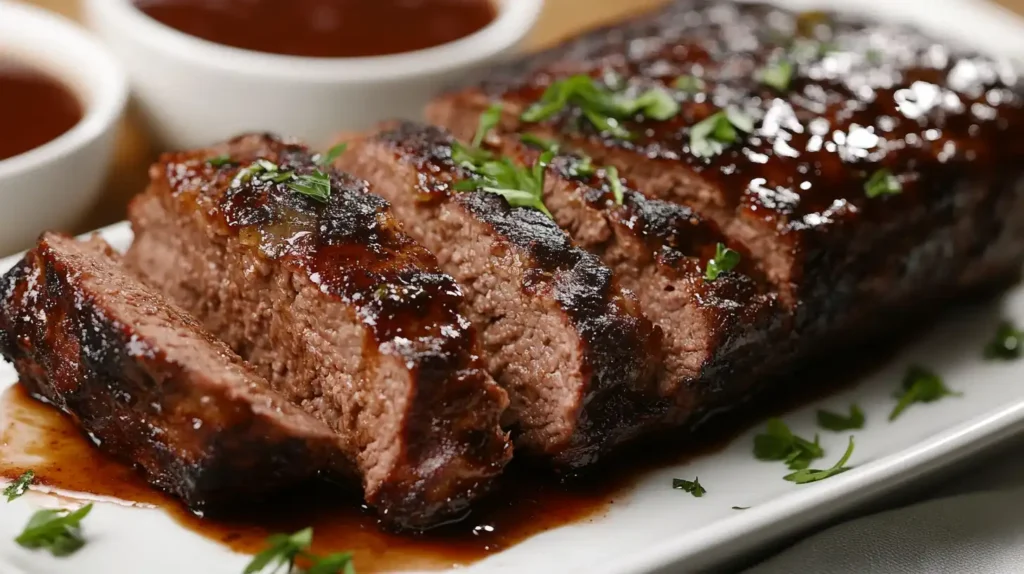Introduction

Meatloaf is a timeless comfort food loved by families everywhere. Whether it’s served for a cozy dinner or prepared for meal prep, this hearty dish never fails to satisfy. But when it comes to baking it to perfection, the debate often arises—should you cook meatloaf covered or uncovered?
Cooking meatloaf might seem simple, but small details, such as covering it while baking, can make a big difference in texture and flavor. In this article, we’ll explore this question in depth and cover essential tips like how long to bake meatloaf at 350 degrees, how to keep it moist, and how to store it properly.
We’ll also dive into toaster oven cooking methods, share secrets to flavorful meatloaf, and answer frequently asked questions. By the end, you’ll have everything you need to make the perfect meatloaf every time.
Let’s get started!
Is It Best to Cook a Meatloaf Covered or Uncovered?
Whether to cook meatloaf covered or uncovered depends on the texture and moisture you prefer. For a moist and tender meatloaf, it’s best to cook it covered with foil during the initial baking time. Covering the meatloaf helps retain moisture and prevents the top from drying out.
However, to achieve a golden-brown crust, remove the foil during the last 15–20 minutes of baking. This approach provides the perfect balance of a juicy interior and a flavorful, slightly crispy topping.
For those who enjoy a firmer, crustier meatloaf, baking it uncovered for the entire cooking time is also an option. Be sure to monitor it closely to prevent over-drying.
Tip: Use a thermometer to ensure the internal temperature reaches 160°F (71°C) for safe consumption.
For those who enjoy experimenting with flavors, consider pairing your meatloaf dinner with a refreshing Pineapple Mango Juice for a tropical twist that complements the savory richness of the dish.
Do You Cover Meatloaf When Baking at 350?
Covering meatloaf while baking at 350 degrees Fahrenheit can make a noticeable difference in the final result. Most cooks choose to cover their meatloaf during the initial baking phase to retain moisture and prevent it from drying out.
When you cover the meatloaf with aluminum foil, it traps steam, ensuring the meat stays juicy and tender. However, it’s important to remove the foil during the last 15–20 minutes of baking to allow the top to brown and develop a delicious crust.
Benefits of Covering Meatloaf While Baking:
- Moisture Retention: Prevents the meatloaf from becoming dry.
- Even Cooking: Distributes heat more uniformly, especially for thicker meatloaves.
- Flavor Preservation: Keeps the flavors locked inside.
When to Skip Covering Meatloaf:
- If you prefer a crispier crust or are using a glaze, baking uncovered for the entire duration may work better.
- Small meatloaf portions or mini-loaves may not need covering since they cook faster and retain more moisture naturally.
To achieve the best results, a hybrid approach—covering initially and uncovering toward the end—offers a balance of moisture and texture.
How Long Do You Cook Meatloaf at 350 Degrees?
Baking meatloaf at 350 degrees Fahrenheit is the most common method, as it allows the meat to cook evenly without drying out.
General Guidelines for Cooking Times:
- Standard Meatloaf (1-2 pounds): Bake for 55–70 minutes.
- Larger Meatloaf (3-4 pounds): Bake for 80–90 minutes.
- Mini Meatloaves (individual portions): Bake for 25–30 minutes.
Key Tip: Always use a meat thermometer to ensure the internal temperature reaches 160°F (71°C) for ground beef or pork and 165°F (74°C) for poultry-based meatloaf.
Important Notes for Cooking Time Adjustments:
- Thinner Meatloaf Pans: Reduce baking time slightly since the meat will cook faster in thinner pans.
- Deeper Pans or Dense Mixtures: May require additional baking time.
- Convection Ovens: Reduce baking time by about 25% compared to traditional ovens.
What Is the Secret to Keeping Meatloaf Moist?
Keeping meatloaf moist is one of the biggest challenges for home cooks. Fortunately, there are a few tried-and-true techniques that can help you achieve juicy, tender results every time.

1. Use a Combination of Meats
Mixing different types of meat, such as ground beef, pork, and veal, can add extra fat and flavor. Lean meats like turkey or chicken tend to dry out faster, so combining them with fattier meats creates a juicier texture.
Best Meat Ratios:
- 70% lean ground beef with 30% pork.
- For poultry-based meatloaf, add finely chopped vegetables or breadcrumbs soaked in milk for moisture.
2. Add Moisture-Rich Ingredients
Including ingredients like milk, eggs, and ketchup in your meatloaf mixture is essential for keeping it moist.
Common Moisture Boosters:
- Milk or Broth: Adds creaminess to the texture.
- Eggs: Bind the ingredients and provide richness.
- Vegetables: Finely chopped onions, carrots, and celery release moisture during cooking.
- Tomato Sauce or Ketchup: Creates a tangy flavor while adding moisture.
3. Avoid Overmixing
Overmixing the meatloaf mixture can result in a dense, dry loaf. Stir the ingredients just until they are combined, and then shape the loaf gently without compacting it too much.
4. Use a Glaze or Sauce
Coating your meatloaf with a glaze not only adds flavor but also locks in moisture.
Popular Glaze Options:
- Classic Ketchup Glaze: Ketchup, brown sugar, and mustard.
- BBQ Sauce: Adds a smoky, tangy flavor.
- Teriyaki Sauce: Provides a sweet and savory twist.
5. Bake with Foil and Rest Before Slicing
As mentioned earlier, covering the meatloaf with foil during the first part of baking helps retain moisture. Once baking is complete, let the meatloaf rest for 10–15 minutes before slicing to allow the juices to redistribute evenly.
How Long to Cook Meatloaf in Toaster Oven?
Cooking meatloaf in a toaster oven is a convenient option, especially for smaller portions or if you don’t want to heat up the entire kitchen.
Cooking Guidelines for Toaster Ovens:
- Temperature: Preheat to 350°F (177°C).
- Time for 1BN–2 Pounds of Meatloaf: Bake for 50–60 minutes.
- Time for Mini Loaves or Muffin Tin Portions: Bake for 20–30 minutes.
Key Tips for Toaster Oven Baking:
- Use a small loaf pan or shape the meatloaf into a compact size to ensure even cooking.
- Cover loosely with foil for the first half of the baking time to prevent drying out.
- Check the internal temperature with a meat thermometer. It should reach 160°F (71°C) for beef or pork and 165°F (74°C) for poultry.
How Long Is Meatloaf Good For?
Proper storage is key to keeping your meatloaf safe and delicious after baking.
Refrigerator Storage
- Freshly Cooked Meatloaf: Store in an airtight container for 3–4 days in the refrigerator.
- Sliced Portions: Wrap each slice in plastic wrap and store in a sealed container to retain moisture.
Freezer Storage
- Uncooked Meatloaf: Wrap tightly in plastic wrap and aluminum foil. Freeze for up to 3 months.
- Cooked Meatloaf: Freeze slices in airtight containers for 2–3 months.
Reheating Tips
- Oven: Reheat at 300°F for 15–20 minutes covered with foil to prevent drying out.
- Microwave: Heat slices in short intervals, covering them with a damp paper towel to preserve moisture.
- Toaster Oven: Reheat at 325°F for 10–15 minutes until heated through.
Preparing Meatloaf: Tips for the Perfect Texture
Achieving the perfect meatloaf texture requires attention to detail, from ingredient selection to mixing techniques. Let’s break down the key steps for making a meatloaf that’s flavorful, moist, and holds its shape.
Choosing the Best Ingredients for Moist Meatloaf
The ingredients you choose play a vital role in the final outcome.
Key Ingredients for a Juicy Meatloaf:
- Ground Meat: A blend of 70% lean beef and 30% pork or veal is ideal. The higher fat content prevents dryness.
- Binder Ingredients: Eggs and breadcrumbs or crushed crackers help hold the mixture together without making it heavy.
- Liquid Additions: Milk, broth, or even heavy cream provides moisture and richness.
- Vegetables: Finely grated onions, carrots, and celery add flavor and moisture while softening during baking.
- Flavor Boosters: Worcestershire sauce, mustard, ketchup, and garlic powder enhance taste without overpowering the meat.
Mixing and Shaping Techniques for Perfect Results
1. Mix Gently to Avoid Density:
Overworking the meat mixture can result in a tough loaf. Use a light touch and mix the ingredients just until combined.
2. Shape Evenly for Uniform Cooking:
Shape the meatloaf into a compact but slightly domed form to help it cook evenly and reduce cracking. Avoid pressing it too firmly.
3. Use a Loaf Pan or Free-Form Baking Method:
- Loaf Pan Method: Provides structure and makes it easier to create layers if you’re adding fillings. However, excess grease can accumulate at the bottom.
- Free-Form Method: Shape the loaf on a lined baking sheet. This method allows grease to drain away and creates more surface area for a crust.
4. Create an Indentation for Glazes:
Make a shallow indentation along the top of the loaf to hold the glaze and prevent it from sliding off during baking.
Oven Baking vs Toaster Oven: Pros and Cons
Choosing between a conventional oven and a toaster oven depends on your needs, kitchen setup, and cooking preferences.
Conventional Oven: Pros and Cons
Pros:
- Ideal for larger batches or family-sized loaves.
- Allows for even heat distribution.
- Accommodates heavier bakeware like cast-iron pans.
Cons:
- Takes longer to preheat.
- Consumes more energy compared to smaller appliances.
Toaster Oven: Pros and Cons
Pros:
- Heats up quickly, saving time.
- Perfect for smaller portions or individual servings.
- Uses less energy, making it cost-effective.
Cons:
- Limited space, making it unsuitable for larger meatloaves.
- May require frequent monitoring to prevent uneven cooking.
Which Option Is Better?
For traditional family meals, the conventional oven is often the go-to choice. However, if you’re cooking for one or two people, a toaster oven can be a convenient alternative.
Common Mistakes to Avoid When Cook a Meatloaf Covered or Uncovered
Even experienced cooks can make mistakes when preparing meatloaf. Here are the most common errors and how to avoid them.
Overmixing the Ingredients
Overworking the mixture can create a dense and rubbery texture. Instead, mix gently until just combined to maintain tenderness.
Not Adding Enough Moisture
Skipping key ingredients like milk, eggs, or vegetables often results in dry meatloaf. Always include moisture-rich elements for a softer texture.
Ignoring the Resting Period
Cutting into the meatloaf too soon causes the juices to escape, leaving it dry. Allow the meatloaf to rest for 10–15 minutes before slicing to lock in moisture.
Flavor Enhancements: Spices, Sauces, and Toppings
Adding the right flavors and toppings can take your meatloaf to the next level.
Popular Seasoning Combinations
- Classic Blend: Salt, pepper, garlic powder, onion powder, and parsley.
- Italian Style: Basil, oregano, thyme, and grated Parmesan cheese.
- Spicy Twist: Cayenne pepper, paprika, and a splash of hot sauce.
Creative Topping Ideas for a Tasty Crust
- Ketchup and Brown Sugar Glaze: A sweet and tangy finish.
- BBQ Sauce and Honey: Adds smoky flavor and a caramelized crust.
- Cheese Topping: Melted cheddar or mozzarella for a gooey layer of flavor.
Try a honey-barbecue glaze or Tomato Basil Bread crumbs as a crunchy topping.
FAQs About cook a meatloaf covered or uncovered
What Temperature Do You Cook Meatloaf To?
The safe internal temperature for meatloaf depends on the type of meat:
- Beef or Pork Meatloaf: 160°F (71°C).
- Chicken or Turkey Meatloaf: 165°F (74°C).
Use a meat thermometer inserted into the thickest part of the loaf to check the temperature accurately.
How to Tell If Meatloaf Is Done?
To determine if your meatloaf is fully cooked:
- Check the Internal Temperature: Insert a meat thermometer into the center of the loaf—it should read 160°F (71°C) for beef and pork.
- Visual Inspection: The juices should run clear, not pink.
- Texture Test: The meatloaf should feel firm but springy when pressed.
What Not to Put in Meatloaf?
Certain ingredients can ruin the texture or flavor of meatloaf. Avoid these common pitfalls:
- Too Many Dry Fillers: Excessive breadcrumbs or oats can make the loaf crumbly and dry.
- Large Vegetable Pieces: Chop vegetables finely to prevent chunks that disrupt the texture.
- Overpowering Flavors: Avoid overly strong spices that mask the natural taste of the meat.
How Long to Cook Meatloaf in a Convection Oven?
Convection ovens cook faster due to circulating hot air.
Cooking Guidelines for Convection Ovens:
- Preheat to 325°F (163°C).
- Bake for 45–55 minutes for a 1–2 pound meatloaf.
- Check the internal temperature—it should reach 160°F (71°C) for beef and pork or 165°F (74°C) for poultry.
Tip: Reduce baking time by about 25% compared to conventional ovens and monitor carefully to avoid overcooking.
Conclusion: Cook Meatloaf Covered or Uncovered
Cooking meatloaf covered or uncovered can impact its texture and flavor, but both methods can deliver amazing results when done right. Covering your meatloaf during baking helps lock in moisture, while uncovering it toward the end gives it a golden, crispy crust.
In this guide, we’ve shared tips for baking meatloaf at 350°F, keeping it moist, and adapting methods for toaster ovens and convection ovens. We also covered ingredient selection, storage tips, and reheating techniques to help you make the perfect meatloaf every time.
With these simple strategies, you can prepare a juicy, flavorful meatloaf that’s sure to impress. Whether you prefer it covered or uncovered, your homemade meatloaf will be a hit for any meal.
Try incorporating ideas from this guide and don’t miss our Chicken Broccoli Rice Casserole for another hearty and satisfying meal option!
